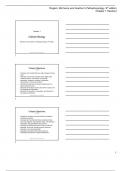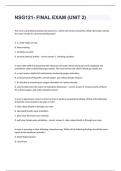Rogers: McCance and Huether’s Pathophsyiology, 9th edition
Chapter 1 Handout
Chapter 1
Cellular Biology
McCance and Huether’s Pathophysiology, 9th edition
Copyright © 2023 Elsevier, Inc. All Rights Reserved. 1
1
Chapter Objectives
(1 of 5)
1. Compare and contrast the two major classes of living
cells.
2. Describe the provide examples of the eight major
cellular functions: movement, conductivity,
absorption, secretion, excretion, respiration,
reproduction, and communication.
3. Identify and describe the three principal parts of a
typical eukaryotic cell.
4. Describe the location and function of the nucleus and
the cytoplasmic organelles.
5. Describe the structure, composition, and function of
the plasma membrane.
Copyright © 2023 Elsevier, Inc. All Rights Reserved.
2
2
Chapter Objectives
(2 of 5)
6. Identify the location and main functions of plasma
membrane proteins.
7. Compare and contrast the three mechanisms that
bind cells together: extracellular matrix, cell adhesion
molecules, and specialized cell junctions.
8. Describe the following primary modes of chemical
signaling: hormonal, neurohormonal, paracrine,
autocrine, and neurotransmitter.
9. Illustrate and describe the first and second
messenger processes in signal transduction.
Copyright © 2023 Elsevier, Inc. All Rights Reserved.
3
3
1
, Rogers: McCance and Huether’s Pathophsyiology, 9th edition
Chapter 1 Handout
Chapter Objectives
(3 of 5)
10. Describe the two main processes associated with
cellular metabolism, and identify the processes as
energy storing (endergonic) or energy yielding
(exergonic).
11. Describe the role of adenosine triphosphate (ATP)
and adenosine diphosphate (ADP) in the transfer of
energy to drive cellular processes.
12. List examples of the following transport mechanisms:
diffusion, passive-mediated transport (facilitated
diffusion), phagocytosis, pinocytosis, active
transport, osmosis, and hydrostatic pressure
(filtration).
Copyright © 2023 Elsevier, Inc. All Rights Reserved.
4
4
Chapter Objectives
(4 of 5)
13. Classify the above cellular transport mechanisms as
active or passive.
14. Compare and contrast the mechanisms of transport
involving vesicle formation.
15. Describe the mechanisms that establish and
maintain the resting potential of a cell membrane.
16. List and describe the sequence of events involved in
an action potential.
17. Identify and describe the phases of mitosis and
cytokinesis.
18. Describe the mechanisms that influence the rates of
cell division.
Copyright © 2023 Elsevier, Inc. All Rights Reserved.
5
5
Chapter Objectives
(5 of 5)
19. Identify the purpose and function of cellular growth
factors.
20. Identify and describe the two main mechanisms of
tissue formation.
21. Identify the location, appearance, and a major
function of each of the following types of tissue:
epithelial, connective, muscle, and nervous.
Copyright © 2023 Elsevier, Inc. All Rights Reserved.
6
6
2
, Rogers: McCance and Huether’s Pathophsyiology, 9th edition
Chapter 1 Handout
Significance of Cells
All body functions depend on the integrity of
the cells.
Understanding cellular biology is necessary
to understand disease.
An overwhelming amount of information
reveals how cells behave as a multicellular
“social” organism.
Ø Cellular communication (cellular crosstalk) is at
the heart of cellular biology.
Copyright © 2023 Elsevier, Inc. All Rights Reserved. 7
7
Prokaryotes and Eukaryotes
Prokaryotes
Ø Characterized by lack of distinct nucleus
Ø Cyanobacteria, bacteria, and Rickettsiae
Eukaryotes
Ø Complex cellular organization
Ø Membrane-bound organelles
Ø Well-defined nucleus
Ø Higher animals, plants, fungi, and protozoa
Copyright © 2023 Elsevier, Inc. All Rights Reserved. 8
8
Cellular Functions
Movement
Conductivity
Metabolic absorption
Secretion
Excretion
Respiration
Reproduction
Communication
Copyright © 2023 Elsevier, Inc. All Rights Reserved. 9
9
3
, Rogers: McCance and Huether’s Pathophsyiology, 9th edition
Chapter 1 Handout
Structure and Function of Cellular
Components
(1 of 17)
Three general components
Ø Plasma membrane
Ø Cytoplasm
Ø Intracellular organelles
Copyright © 2023 Elsevier, Inc. All Rights Reserved. 10
10
Structure and Function of Cellular
Components
(2 of 17)
Nucleus
Structure
Ø Nuclear envelope
Ø Nuclear pore complexes
Ø Nucleolus
Ø Ribonucleic acid (RNA)
Ø Deoxyribonucleic acid (DNA)
Ø Histone proteins
Functions
Ø Cell division and control of genetic information
Copyright © 2023 Elsevier, Inc. All Rights Reserved. 11
11
Structure and Function of Cellular
Components
(3 of 17)
Cytoplasm
Fills the space Functions
between the nuclear Ø Synthesis and
envelope and the transport
plasma membrane. Ø Isolates and eliminates
wastes.
Structure
Ø Metabolic processes
Ø Cytoplasmic matrix
Ø Maintenance of cellular
Ø Cytosol
motility
Ø Cytoplasmic
organelles Ø Storage
Copyright © 2023 Elsevier, Inc. All Rights Reserved. 12
12
4





